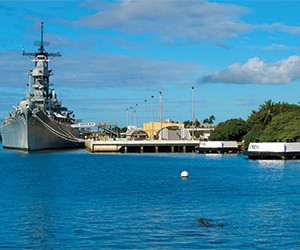There’s only one place in the world where you can walk in the footsteps of monarchs, be a paniolo for a day, learn how to hula and stand on the battleship where a world war officially ended. That place is the Hawaiian Islands, and for all its natural wealth, it is just as endowed with cultural riches.
“From every market segment, culture is becoming thankfully more relevant—it’s sort of a competitive advantage,” said Kainoa Daines, director of sales for the Oahu Visitors Bureau and cultural advisor for the Hawaii Visitors and Convention Authority since 2002. “Adding culture to an agenda is almost becoming very necessary. At the beginning of a conference, you have to have a Hawaiian blessing.”
Wherever groups gather in Hawaii, there is history, heritage and plenty of warm aloha hospitality in store.
Oahu
The compelling balance of Polynesian and American heritage sets Oahu in a class by itself culture-wise, according to Daines.
The unique mix includes some of the country’s most prominent attractions: Bernice Pauahi Bishop Museum, Iolani Palace and Pearl Harbor.
“Iolani Palace is a beautiful venue, and it’s the only royal palace on U.S. soil,” Daines said. “The ambience is immediately elevated when you hold events there. Every event is worthy of royalty, as if the king or queen were attending.”
The opulent former regal residence, built in 1882, is a treat to tour, while it is also well suited for events. Iolani Palace has numerous spaces for private functions, including attractive outdoor lawn areas, and can accommodate up to 8,000 people.
Bishop Museum, known as the Hawaii State Museum of Cultural and Natural History, is another stellar choice for group tours and events.
“Bishop Museum has an excellent gigantic great lawn and it’s a historic museum,” Daines said. “It has the largest collection of Hawaiian and Polynesian artifacts and art, and it is Hawaii’s first museum.”
The Bishop was founded in 1889, and its 14-acre site features an exceptional array of space for events, including conference rooms and outdoor lawns.
Two other standout cultural sites for events are the Battleship Missouri Memorial and the Pacific Aviation Museum.
“World War II ended onboard the USS Missouri,” Daines said. “I don’t know many places where you can have an event where such a legendary part of history took place.”
The USS Missouri hosts an array of small to large events, from meetings and receptions to theme parties complete with 1940s-era swing jazz bands and period attire.
Meanwhile, attendees can gather for events amid World War II fighter jets, helicopters and planes at the Pacific Aviation Museum on historic Ford Island. Photo ops include climbing into a cockpit to snap a selfie in a magnificent warbird. The museum can accommodate gatherings of up to 10,000 people.
This Dec. 7 marks the 75th anniversary of the surprise attack on Pearl Harbor, and Hawaii is commemorating the historic day with a series of events.
Kauai
Known as the Garden Isle, Kauai is easy on the eyes, and it’s also beautiful when it comes to authentic cultural experiences. The island’s myriad festivals will have groups living like locals, while museums and other cultural institutions dig deep into the rich heritage of Hawaii.
“Festivals and local events allow our visitors to experience the cultural side of our island and become a part of our community,” said Lisa Nakamasu, director of sales for meetings, conventions and incentives at the Kauai Visitors Bureau.
Nakamasu said groups can plan visits around some of the island’s most popular annual multiday cultural festivals, including Koloa Plantation Days, held in July and commemorating the island’s sugar plantation heritage, and Waimea Town Celebration, held in February and celebrating Hawaii’s rich history and community.
Meanwhile, the island is home to several museums. Kauai Museum in Lihue is a great place for groups to immerse themselves in the island’s heritage. The museum, a historic venue in itself, features exhibits chronicling Hawaii’s history and featuring art and artifacts, cultural events and educational programs. Guests can participate in offerings such as coconut frond-weaving and hula classes, or enjoy Hawaiian concerts.
Other unique experiences of the island’s heritage take in the destination’s natural bounty.
“What has been very popular is the fact that our activities incorporate the history of the land and the island as well as the cultural aspects,” Nakamasu said.
The National Tropical Botanical Garden, according to Nakamasu, is one of the most popular options for groups. The organization has several gardens throughout Hawaii, with two that are ideal for groups on the south shore of Kauai.
“It’s a very educational and cultural experience,” she said. “There’s a lot of history to this piece of property. It basically is to do research on plants for medicinal purposes. They are also trying to save and preserve endangered species.
“Groups tour Allerton Garden and learn about the garden and the history of the land,” she added. “Then they go down to the lower area, which is a private beach, and they have a reception there.”
PageBreak
Maui
With one of the region’s best arts centers, historically significant gardens and ranches, and towns rich with heritage sites, Maui makes a bold and bright cultural statement.
“Maui was named for the Hawaiian demigod, Maui, who was responsible for bringing fire to the people and slowing the sun to lengthen our days,” Daines said. “This mythological figure connects Hawaii to the rest of the Pacific, as so many other Polynesian cultures share the myths of Maui.”
The Maui Arts & Cultural Center in Kahului is the island’s premier venue celebrating local and regional arts and culture, as well as bringing acclaimed artists from around the world to perform on its stages and exhibit in its galleries. Among its varied lineup of concerts, performances, exhibits and educational programs, groups can absorb Hawaiian heritage via offerings such as ukulele workshops and festivals, vintage Hawaiian fashion shows and folkloric Hawaiian dance performances, to name a few. The center is also available for meetings and a variety of events.
Meanwhile, groups can visit Hana’s Kahanu Gardens, part of the National Tropical Botanical Garden, and discover one of the island’s most naturally beautiful sites, and one of Hawaii’s most historic.
“Kahanu Gardens stands out for me as it is home to the largest heiau in the Pacific, Piilani Heiau,” Daines said. “Its cultural significance is profound, celebrating the paramount chief at the time, Piilani.”
The history of Hawaii’s famed paniolo (cowboy) is ready to be wrangled at Ulupalakua Ranch (www.ulupalakuaranch.com/history.htm). A scenic drive up the leeward slopes of Haleakala leads to the historic ranch, which originally opened in 1845. Ulupalakua is Maui’s second-largest cattle ranch, with 18,000 acres of land that starts at the ocean and climbs up the mountain to roughly 6,000 feet in elevation.
Aside from admiring great views, groups can learn about the history of the ranch, cattle production and local agricultural heritage, go horseback riding and sport clay shooting, and indulge at the ranch’s winery and restaurant. The eatery specializes in grilled meats such as lamb, beef and elk, all from the ranch or elsewhere on Maui, as well as local produce.
On the northeastern coast of the island, Historic Lahaina is one of Hawaii’s treasures. Lahaina was the capital of the Kingdom of Hawaii from 1820 to 1845. In addition to Lahaina’s quaint setting, restaurants and shops, a wealth of historic sites are being preserved and promoted under the Lahaina Restoration Foundation. Its mission is to ensure that Lahaina’s prominent place in Hawaii’s history and rich cultural traditions is celebrated and shared.
More than a dozen historic sites are represented through the Lahaina Restoration Foundation, including the Baldwin Home Museum, Masters’ Reading Room, Old Lahaina Courthouse, Lahaina Heritage Museum, Hale Pai Printing Museum and Hale Paahao Prison. Dating to the height of Lahaina’s whaling era of the 1850s, Hale Paahao Prison sets a historic, lush backdrop for small to midsize receptions, dinners and other functions.
The Island of Hawaii
The Island of Hawaii’s claim to cultural fame starts with King Kamehameha the Great, who formally established the kingdom of Hawaii in 1810 following years of conflict.
“His birthplace is on the northern part of the island, and going back before the islands were unified, they all had many chiefs,” said Debbie Hogan, senior director of sales for the Big Island Visitors Bureau. “He eventually unified all of the Hawaiian Islands under one ruler.”
There are numerous cultural institutions where groups can experience the history of King Kamehameha, but one standout is Puukohola Heiau National Historic Site in Kawaihae on the northwestern coast of the island, according to Hogan.
“This is a heiau, a secret Hawaiian temple, which was built by Kamehameha to unify the islands, and it is still intact,” Hogan said. “It’s an attraction that groups can visit, and national park rangers are there to explain the significance of the historic site.”
The Hawaiian monarchy theme plays out at another top heritage site for groups on the Big Island: Hulihee Palace in Kailua-Kona. Built in 1838, it was used as a summer vacation home for Hawaiian royalty, and today it is a museum showcasing Victorian treasures.
“There are three palaces in the United States: two on Oahu and one on our island,” Hogan said. “Hulihee Palace; it’s a beautiful site, with an ocean side, and with the sun setting it’s a really nice place to hold events in the outdoor area. It can comfortably hold about 500 people, but we have had receptions of up to a couple thousand guests.”
Meanwhile, Kona coffee is a trademark lure of the Big Island, and groups are treated to a unique experience of its heritage through the Kona Historical Society. Its Kona Living History Farm is a throwback to the first half of the 20th century, as groups tour the homes of Japanese immigrants who started growing coffee in Kona. Costumed interpreters are on-hand to “talk story” about the history of the farm.
“After the unification of the islands, you started to see immigrants coming to Hawaii, and with Kona coffee, it was the Japanese who started growing it and harvesting it here,” said Kuulani Auld, program director of the Kona Historical Society. “There were a lot of different cultures culminating on the islands, including those from Japan, China, Korea, Mexico and Portugal.”
Kona has a rich history of Portuguese settlers, and the Kona Historical Society preserves their heritage with a traditional wood-fired stone oven in a pasture next to N.H. Greenwell Store Museum.
“Every Thursday, Portuguese sweet bread is made in the large oven, and people from the community as well as visitors come out to learn how to roll bread and bake,” Auld said. “This is something that we have also added to group events that can be held on the large outdoor lawn here. It’s a very authentic experience of the island.”







